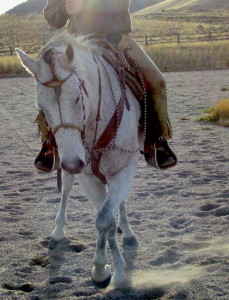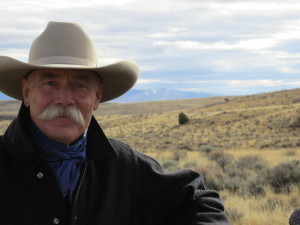 Randy Rieman fulfilled his childhood dream of becoming a horseman when, in his early 20’s he left the Midwest and traveled to Montana. With a keen willingness to work hard and an enthusiasm for learning, he connected with many fine horseman, including Bill and Tom Dorrance in California. For the past 30 years, he has honed his craft in California, New Mexico, Hawaii, and, of course, Montana, which he now calls home. Along the way, he’s also risen to the top as a rawhide braider and a cowboy poetry reciter. He travels nationally and internationally to share what he’s learned. Visit his website.
Randy Rieman fulfilled his childhood dream of becoming a horseman when, in his early 20’s he left the Midwest and traveled to Montana. With a keen willingness to work hard and an enthusiasm for learning, he connected with many fine horseman, including Bill and Tom Dorrance in California. For the past 30 years, he has honed his craft in California, New Mexico, Hawaii, and, of course, Montana, which he now calls home. Along the way, he’s also risen to the top as a rawhide braider and a cowboy poetry reciter. He travels nationally and internationally to share what he’s learned. Visit his website.
Here, Rieman discusses the need to balance what you read or watch with actual doing.
Register for Randy Rieman Clinic, September 24-26. Click here.
Read about his Dorrance memories.
Read about Randy, as a Renaissance Man.
Balancing the philosophical and the practical.
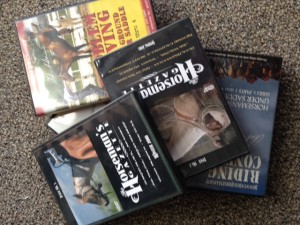 There is a certain amount of practical application that you’ve got to accomplish. To tell yourself: How much is enough or how much is too much, you know? You can’t leave out the nuts and bolts. You can’t just have the philosophical, idealistic stuff. The two go hand in hand.
There is a certain amount of practical application that you’ve got to accomplish. To tell yourself: How much is enough or how much is too much, you know? You can’t leave out the nuts and bolts. You can’t just have the philosophical, idealistic stuff. The two go hand in hand.
I don’t know anybody who cannot take ahold of the horse and get it to bend to disengage the hip, or to step the front foot over. That’s a mechanical thing. But do they know about when to ask? Is he prepared for a good attempt? You’ve got to have an achievable goal.
BHP: You can’t ask a horse to open a gate before you’ve taught a horse to move sideways.
RR: Exactly. Or, before he’s learned to wait on you.
- initiate motion
- change direction
- and if my horse can wait on me to be asked to move
Then, I can just about do anything. It won’t be very pretty, but I can get it done.
Those are certain foundational things you’re going to have to have. If my horse is going into self-defense when he sees me coming with the saddle, then I’ve got to work there until that problem is gone. That problem (if left unaddressed) will form the foundation for a bunch of problems later, because he didn’t get the proper preparation at the right time.
I had a horse here that was really bad to buck, and I talked to the people about it and they said, “Yeah, this sucker bucks every time.” They claimed to have saddled him 30-40 times. They never got him prepared to be saddled. They just saddled him and turned him loose, bucking. So, when he would do that, they’d quit. They’d leave him.
I said, “Well, did you ever saddle him like 20 times in the row? So that his response at the end was different than the response at the beginning?”
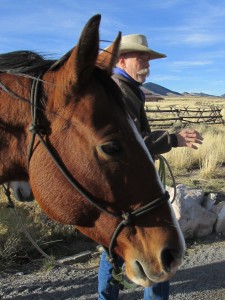 They said “No, why would you ever do that?”
They said “No, why would you ever do that?”
They brought him over and we saddled him maybe a dozen times. He’d buck around there, and I’d take the saddle off and move his feet around and re-saddle him. On about the tenth time, he just kind of let his air out, licked his chops, and walked off.
I said, “OK, this is where we quit. We don’t take advantage of him. We quit here. We let him have that victory. The next time, it might take a few saddlings. But eventually, he just didn’t want to do that anymore. He was just is like, “you know what? This is a lot easier if I just walk off here.”
His owners were totally amazed. But, you see, they weren’t thinking deeply enough about what they were doing. That’s all. And now, they know that. They can use what they learned again.
Same thing with this little filly I have: She was worried about getting petted on. I just kept pettin’, kept pettin’, kept pettin’, and if she tried to get away, I’d just persist until she stopped trying to get away.
If she pulled on the halter, that’s OK. She’s doing what she thinks she needs to do to survive, because her self-defense mechanism has been stimulated by this particular movement.
But if I gave her enough of a chance, if I let her work hard enough at the wrong thing, she starts looking for an alternative behavior to replace it. I just got have to be make sure that I reward the right thing. See?
BHP: I imagine if you’d played your cards differently and, for instance, got things OK, but then went straight to saddling and riding, you might have found yourself with holes in the training.
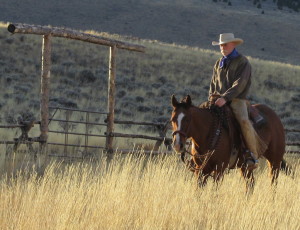 RR: Yeah. I think of it this way, if you’re going to resolve a problem or a conflict, you can’t get up to that conflict and retire. You have to get through to the other side. I can’t quit. As much as I want to ride this filly, I have to get this spot taken care of first.
RR: Yeah. I think of it this way, if you’re going to resolve a problem or a conflict, you can’t get up to that conflict and retire. You have to get through to the other side. I can’t quit. As much as I want to ride this filly, I have to get this spot taken care of first.
I was a springboard diver in college. You don’t start out doing triple gainers with half twists. You start out doing a swan dive, or a back dive. You start with simple stuff: my approach and my takeoff are the foundation for success in my dive. If my approach is bad, my dives are always going to be bad. I can’t make up for it in the air.
BHP: Do you think the milestones and levels of accomplishments that humans establish are, in the horses’ mind, completely arbitrary? For the horse, getting to a point where the she’s calm for saddling, that, in fact, is a tangible milestone for her.
RR: Absolutely. And it’s way more important than a mediocre ride.
A milestone for one person won’t necessarily fit another. I’m not going to tell people what I do, I’m going to maybe tell ’em, “I don’t do that because I’ve found it to be counterproductive or too difficult or too complex for where the horse is.”
